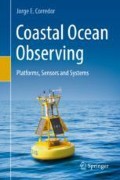Abstract
Electronic instruments and platforms, especially the mobile platforms, require a stable source of electrical power which in most cases is not available from a large-scale terrestrial power grid. Batteries alone for submerged applications or combinations of solar cells and batteries for surface applications are the principal power sources now in use, but wave, wind, and other power sources are becoming available. Significant power economy afforded by modern electronic systems now extends power autonomy beyond 1 year for certain applications. Sensitive electronic components for ocean observing are contained in pressure-resistant housings constructed from corrosion-resistant materials or otherwise protected from corrosion. Pressure housings must be provided with waterproof ports for external sensors, power, and data cables. Metal structures are subject to electrochemical seawater-induced corrosion, in many cases mediated by bacterial metabolism. Metal structures immersed in seawater can be protected using both passive and active strategies, the former employing sacrificial metals and the latter the use of impressed electrical current. Biofouling can severely impair instrument response and vehicle performance. Mechanical means (wipers, shutters, slick surfaces) and/or biocidal means (organometallic formulations) allow reduction or amelioration of biological fouling. Special consideration is due to anchoring systems and electrical wires and cables subject to abrasion in high energy marine environments.
The original version of this chapter was revised. A correction to this chapter can be found at https://doi.org/10.1007/978-3-319-78352-9_9
Access this chapter
Tax calculation will be finalised at checkout
Purchases are for personal use only
References
Bahador A. Cathodic corrosion protection systems: a guide for oil and gas industries. NY: Elsevier; 2014. ISBN: 9780128003794. 492 p.
Brown BF. Corrosion. In: Myers JJ, Holm CH, McAllister RF, editors. Handbook of ocean and underwater engineering. Section 7: Materials and testing marine corrosion, boring and biofouling. New York: McGraw Hill; 1969. pp. 3-4 to 3-30.
Delauney L, Compere C, Lehaitre M. Biofouling protection for marine environmental sensors. Ocean Sci. 2010;6:503–11. https://doi.org/10.5194/os-6-503-2010. www.ocean-sci.net/6/503/2010/. Accessed 15 Sept 2017.
Dewan A, Ay SU, Nazmul Karim M, Beyenal H. Alternative power sources for remote sensors: a review. J Power Sources. 2014;245(2014):129–43.
Di Donato P, Poli A, Taurisano V, Abbamondi GR, Nicolaus B, Tommonaro G. Recent advances in the study of marine microbial biofilm: from the involvement of quorum sensing in its production up to biotechnological application of the polysaccharide fractions. J Mar Sci Eng. 2016;34:14. https://doi.org/10.3390/jmse4020034.
Enning D, Garrelfs J. Corrosion of Iron by sulfate-reducing Bacteria: new views of an old problem. Appl Environ Microbiol. 2014;80(4):1226–36.
Enning D, Venzlaff H, Garrelfs J, Dinh HT, Meyer V, Mayrhofer K, Hassel AW, Stratmann M, Widdel F. Marine sulfate-reducing bacteria cause serious corrosion of iron under electroconductive biogenic mineral crust. Environ Microbiol. 2012;14(7):1772–87. https://doi.org/10.1111/j.1462-2920.2012.02778.x. PMCID: PMC3429863.
Froelich PN, Klinkhammer GP, Bender ML, Luedtke NA, Heath GR, Cullen D, Dauphin P, Hammond D, Hartman B, Maynard V. Early oxidation of organic matter in pelagic sediments of the eastern equatorial Atlantic: suboxic diagenesis. Geochimica et Cosmochimica Acta. 1979;43(7):1075–90.
Galler SR. Boring and fouling. In: Myers JJ, Holm CH, McAllister RF, editors. Handbook of ocean and underwater engineering. Section 7: Materials and testing marine corrosion, boring and biofouling. New York: McGraw Hill; 1969. pp. 7-12 to 7-19.
Horne RA. Marine chemistry. New York: Wiley-Interscience; 1969. 568 p.
Lobe H, Haldemann C, Glenn SC. ClearSignal coating controls biofouling on the Rutgers glider crossing. Sea Technology. 2010. https://wwwsea-technologycom/features/2010/0510/clearSignal_coating_controlshtml#top. Accessed 14 Sept 2017.
Millero FJ. Chemical oceanography. 4th ed. Boca Raton: CRC Press Taylor & Francis Group; 2013. 571 p. ISBN 9788-1-4665-1249-8.
Pierce GA, Romanelli RP. Cable installation and Repair. In: JJ Myers, CH Holm, RF McAllister (Eds.). Handbook of ocean and underwater engineering. Copyright by North American Rockwell Corporation. New York: McGraw Hill; 1969. pp. 5–29 to 5–51.
Railkin AI. Marine biofouling: colonization processes and defenses. Boca Raton: CRC Press; 2004. 300 pp. ISBN-13: 978-0849314193 ISBN-10: 0849314194.
Rimmer M, Wang Q. Assessing the effects of alkaline desalination treatments for archaeological iron using scanning electron microscopy. Br Museum Tech Bull. 2010;4:79–86.
Rudnick DL, Davis RE, Eriksen CC, Fratantoni DM, Perry MJ. Underwater gliders for ocean research. Mar Technol Soc J. 2004;38(2):73–84.
Salta M, Wharton JA, Blache Y, Stokes KR, Briand J-F. Marine biofilms on artificial surfaces: structure and dynamics. Environ Microbiol. 2013;15(11):2879–93.
Statsewich H, Weingartner T, Grunau B, Egan G, Timm J. A high-latitude modular autonomous power, control and communication system for application to high-frequency surface current mapping radars. Mar Tech Soc J. 2011;45(3):59–68.
Steinberg PD, de Nys R, Kjelleberg S. Chemical cues for surface colonization. J Chem Ecol. 2002;28:1935–51.
Vanýsek P. Electrochemical series. In: Haynes WM, editor. CRC handbook of chemistry and physics. 91th ed. Boca Raton: CRC Press/Taylor & Francis Group; 2010. ISBN-13: 9781439820773. pp. 8-20–8-29.
Videla HA, Herrera LK. Microbiologically influenced corrosion: looking to the future. Int Microbiol. 2005;8(3):169–80.
Whitfield M, Turner DR. Sea water as an electrochemical medium. In: Whitfield M, Jagner D, editors. Marine electrochemistry. Chichester: Wiley; 1981. p. 1–63.
Author information
Authors and Affiliations
Rights and permissions
Copyright information
© 2018 Springer International Publishing AG, part of Springer Nature
About this chapter
Cite this chapter
Corredor, J.E. (2018). Environmental Constraints to Instrumental Ocean Observing: Power Sources, Hydrostatic Pressure, Metal Corrosion, Biofouling, and Mechanical Abrasion. In: Coastal Ocean Observing. Springer, Cham. https://doi.org/10.1007/978-3-319-78352-9_4
Download citation
DOI: https://doi.org/10.1007/978-3-319-78352-9_4
Published:
Publisher Name: Springer, Cham
Print ISBN: 978-3-319-78351-2
Online ISBN: 978-3-319-78352-9
eBook Packages: Earth and Environmental ScienceEarth and Environmental Science (R0)

